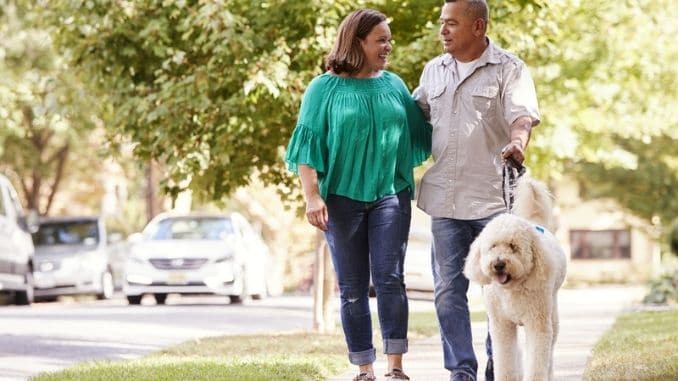Our pets have always been important to us, but we really learned to appreciate them during the COVID-19 pandemic. With government lockdowns in place, many of us felt lonely and isolated at times. Fortunately, our four-legged friends were there to help us cope with those feelings.
“A lot of us are connecting remotely with other people right now,” pet researcher Megan Mueller told Tufts University, “and that’s great. But pets are physically present in a way that other forms of social and emotional support aren’t these days for many people, and there’s really something to having that tactile component of petting or touching a pet.”
No matter what's going on in the world, our pets are good for us, scientists say. They help promote better physical and mental health and provide a unique type of companionship that is hard to replace.
If you haven’t already, here are seven reasons why you may want to consider welcoming a new pet into your home.
1. Pets Help Ease Stress
Stress levels for most people have gone up over the past year. The simple act of petting an animal can help. In a 2019 study, researchers found that just 10 minutes of petting a cat or dog helped reduce levels of cortisol, one of the main stress hormones. It also stimulates an automatic relaxation response, promoting the release of serotonin, prolactin, and oxytocin—all hormones that help lower anxiety and boost mood.
These benefits have prompted some employers to allow pets at work. Scientists reported in 2012 that employees who brought their dogs to work experienced less stress over the course of the day, while those without pets experienced more stress. More specifically, those who brought dogs had an 11 percent decline among average stress scores throughout the day, while their dogless counterparts had a 70 percent increase in stress.
2. Pets Reduce Risk of Heart Disease
Heart disease remains the number-one killer of men and women worldwide. Healthy habits like eating well and exercising regularly can help you avoid it, but research shows that having a dog is a good idea, too.
Dog owners have lower blood pressure levels than non-dog owners, most likely because dogs help relieve stress and also because they encourage people to get more exercise. Some research suggests that those who own dogs experience less cardiovascular reactivity during periods of stress, meaning their heart rate and blood pressure stay closer to normal, even when they’re stressed out.
In a 2013 statement from the American Heart Association, scientists noted that not only did pet ownership seem to reduce blood pressure, it might also lower cholesterol levels, boost exercise activity, and reduce obesity, essentially lowering several risk factors associated with cardiovascular disease. They also noted that pet ownership could help protect heart health in those who already had cardiovascular disease, potentially increasing survival.
Perhaps most impressive was a 2019 analysis of nearly 4 million people in the U.S., Canada, Scandinavia, New Zealand, Australia, and the United Kingdom. The results showed that dog ownership was associated with a 24 percent lower risk of dying from any cause. If a person had already suffered a heart attack or stroke, they were 31 percent less likely to die of cardiovascular disease if they had a dog.
3. Pets Provide Therapy and Support
There's a reason we're seeing so many more support animals around these days. Whether for individuals with autism, attention-deficit hyperactivity disorder (ADHD), anxiety disorders, or cancer, pets can provide comfort and support to help people manage their daily activities and enjoy a higher quality of life.
A 2015 study, for instance, found that children with ADHD who read to real animals experienced more improvements in sharing, cooperation, volunteering, and behavioral problems than children who read to stuffed animals.
Autistic children, too, often improve when around real animals. In one study, children with autism spectrum disorder (ASD) demonstrated more social approach behaviors like talking, looking at faces, and making tactile contact when in the presence of real animals compared to toys.
“These results suggest that the presence of an animal can significantly increase positive social behaviors among children with ASD,” the scientists wrote.
Animals can also help decrease anxiety and pain in people undergoing medical treatment, too. In a 2015 study, researchers found that cancer patients who were visited by therapy dogs experienced significant increases in overall well-being. A similar study the same year reported that pet therapy helped calm breast cancer patients, easing their anxiety and stress and promoting better communication with health professionals.
4. Pets Are Great for Seniors
For seniors and elderly people, pets can be life-savers. In one study, researchers found that those with a cat or dog were better able to perform normal daily activities such as climbing stairs, bending and kneeling, preparing meals, and taking medication. The researchers also suggested that taking care of a pet might give seniors a sense of responsibility and purpose that contributed to overall well-being.
Pets can also help owners avoid loneliness, which is particularly difficult for seniors, who often lose social connections with age. A pet can help counteract these losses by providing steady companionship, which in turn, protects health.
Loneliness is known to increase the risk of health problems, including heart disease, depression, and cognitive decline. Companion animals lower these risks. In a 2017 study, researchers found that homebound older adults experienced a reduced risk of depression and loneliness if they owned a cat or a dog.
Pet therapy can also be extremely beneficial for older individuals in long-term care facilities. Researchers found that elderly individuals affected by dementia, depression, and psychosis, after spending time with a pet, experienced improvements in symptoms of depression and cognitive function.
5. Pets Make Us More Social
Social connections are good for us, and dogs in particular can help us engage in more social interactions. Just taking a walk with your dog can help you appear more friendly and approachable to other people. In one study of people in wheelchairs, researchers found that those who had a dog received more smiles and had more conversations with people passing by than those who didn’t have a dog.
In a later study, researchers watched 1,800 people as they approached a female experimenter under different conditions. Sometimes the experimenter had a dog with her, and other times she had a potted plant or teddy bear. The results showed that more people ignored her when she was alone or with the plant or stuffed animal, but when she was walking a dog, she received more smiles and verbal responses.
Having a dog can help you get to know your neighbors too. In a 2015 study, researchers found that “being a dog owner” was ranked third in the most common ways people met others in their neighborhoods (behind simply being neighbors or going to a local park).
Owning a dog could even improve your dating life. Data from a 2014 survey showed that women were more likely to be attracted to men who owned pets. Men were also more than twice as likely to admit that they’d used a pet to lure a potential date.
Meanwhile, all these social connections benefit your health. In one study, scientists found that stronger social networks improved overall survival by 50 percent.
6. Pets Can Help Reduce Pain
Millions of people live with chronic pain conditions. Owning a pet could help them cope, as we have evidence that pets have a way of easing the perception of pain.
After examining about 300 therapy dog visits in a chronic pain clinic, researchers found that the animals helped reduce the pain (by 23 percent) and emotional distress the patients were feeling. They also improved well-being in the friends and family members who accompanied the patients.
Scientists think this has something to do with the hormones that are released when we pet an animal. Oxytocin, for instance, increases individual pain thresholds. Dopamine, as well, is associated with pleasurable feelings.
The fact that pets can encourage people to be more active is also important. Walking helps control weight, increase strength and flexibility, and reduce joint pain, and can contribute to a better night’s sleep, which in turn, reduces pain.
The American Academy of Family Physicians even suggested in 2015 that physicians consider animal-assisted therapies when seeking alternative ways to manage chronic pain.
7. Pets Protect Your Overall Health
Though pets can provide a lot of unique health benefits, perhaps their real gift lies in how they can improve your health overall.
Researchers found this to be true after surveying about 9,000 people twice over five years. They found that people who owned pets had fewer office visits than those who didn't. Those with a pet at the time of the first survey had the fewest visits, followed by people who had acquired a pet by the second survey.
Another study found similar results—those who were dog owners had fewer office visits, took fewer sick days, and exercised more often than non-dog owners.
Even better—having a pet may help you live longer. In a study following 3.4 million people, researchers found that owning a dog could decrease the risk of death by 33 percent.
 It’s true what American journalist and nonfiction writer John Grogan said: “Such short little lives our pets have to spend with us, and they spend most of it waiting for us to come home each day. It is amazing how much love and laughter they bring into our lives and even how much closer we become with each other because of them.” The value of pet ownership is truly immeasurable, so be especially thankful for your furry family members.
It’s true what American journalist and nonfiction writer John Grogan said: “Such short little lives our pets have to spend with us, and they spend most of it waiting for us to come home each day. It is amazing how much love and laughter they bring into our lives and even how much closer we become with each other because of them.” The value of pet ownership is truly immeasurable, so be especially thankful for your furry family members.
Learn how to stop the harmful effects of stress and take control of your life. Click here to discover how.











